|
FAQs about Sea Fan Identification
2
Related Articles: Sea
Fans,
Related FAQs: Gorgonian, Sea Fan Identification 1,
Sea Fan ID 3, Sea Fan ID 4, & Sea
Fans 1, Sea Fans 2,
Sea Fan Behavior, Sea Fan Selection, Sea Fan Compatibility, Sea Fan Systems, Sea Fan Feeding, Sea Fan Disease, Sea Fan Reproduction,
|
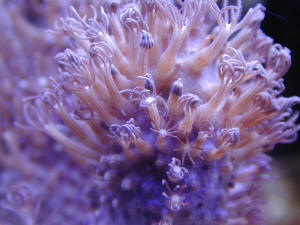
|
|
Gorgonian ID / advice 4/8/09
Hi there!
Can you please help me ID this gorgonian. The seller told me it
was photosynthetic and I tend to trust him, but then again...
Polyps tend to come out when light opens but could be a
coincidence as they frequently open and close during day and
night and I only had it for a few days. I believe it is not the
so called blueberry gorgonian.
Can you ID it?
<Mmm, am hoping this is a Acalycigorgia species... If so, is
non-photosynthetic.... a filter feeder on small
plankton...>
Do you believe it's normal for it to have the polyps closed
for long periods of the day and to open and then close again
after some time (often only an hour opened)?
<Many cyclicities are off-set by aquarium conditions, the
animals "adjusting" to other influences over time...
e.g. the availability of foods>
There are two small wounds on the branches (you can see this on
the pic) and polyps almost always don't open there. Should I
wait and see or immediately cut below it?
<I'd be waiting, reading for now... trying various food
types... experimenting with culture of same>
Many thanks!
Dominique
<Welcome. Bob Fenner>
|
 |
|
Identification please 6/1/08 Hey
WWM Crew, Ken here. Love your sight. Last week I bought a Clove
Polyp colony and after getting it in my tank I noticed a
different specimen toward the back of the rock. Eight
'arms' per polyp and it spreads via a dark purple mat and
at close inspection the 'arms' are fringed if that helps.
At the bottom right corner of the rock are two that look the same
but are completely white. Should I split the rock so the bigger
Clove Polyps don't overgrow them? <Yes, I would> Leave
them alone to fend for themselves. I was hoping an ID could help
me make the decision in case I had to worry about chemical
warfare. Thanks in advance, Ken <This is very likely an
encrusting/creeping Gorgonian (Sea Fan), like Briareum... can be
very invasive, competitive. I would do as you state (if you
desire to culture the Clove Polyps) and separate these colonies,
keep them to their own "patch rocks". Bob
Fenner>
|
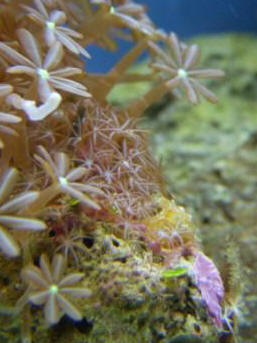 |
Purple Gorgonian
I.D. 4/30/08Hello all, <Andrew> This is another one of those questions I
hate to be asking. For the record I do love to read through the
FAQ's as a general rule, for no more than mental stimulation at
times. Though a lot of the time I do use them as reference's for my
own reef problems. On this occasion I have not been able to find an
answer to what seems like a very simple question!! I wonder if you
might be able to help me identify this beautiful purple Gorgonia I
purchased over the weekend. Sorry, I know the picture quality isn't
fantastic, but I was forced to take this pic on my phone. As you can
see it's a vibrant purple when the polyps are extended. when closed
its quite a striking maroon colour. <Yes> At the moment its
placed up front where it can be fully appreciated, but am not sure if
it would prefer more subdued lighting. <I do think you're
right> I know that non photosynthetic gorg's are notoriously
difficult, well almost impossible to keep alive, but really want to
"save" this little guy ( actually about 30cm high and 20cm
across). Of course I'm sure a rock face in open, nutrient rich
water would be its preferred home, but as long as its already been
removed - I wanted to give it my best shot! <Okay> This tank has
been up for 3 years now, and is doing swimmingly (Ummm, no pun
intended!) and the only filtration I run is an over head wet/dry
trickle filter. I don't skim - never have - and have found it to be
a most effective system. I believe this will aid in the feeding of non
Photosynthetic organisms. <Agreed> Tank is 285L, Spec. Grav is at
1.024, Ammonia 0, Nitrite 0, Nitrate 20ppm, pH 8.0 I don't test for
calcium or phosphates, or anything else for that matter. but do weekly
water changes of 20 litres, with a light gravel vac around the front of
the tank only. I add iodide, calcium, strontium, and a reef buffer when
I do my water changes. I find the best tester is the life in the tank!
If it looks happy, then it probably is, I've based my reef care on
this philosophy since day dot, and it seems to work! Anyhoo, I hope
this hasn't been to much of a bother, but I just couldn't find
this species online, and really want to do as much as possible to keep
it happy and healthy. Thanks a million. Andrew <I think this is
likely an Ellisella species... a "Sea Whip" or Whip Coral.
Bob Fenner> <RMF lost the
graphic...>
| Blueberry Gorgonian ID 1/16/08
Hi Bob, <Hello Peggy> Would you happen to know the species
name of the Blueberry Gorgonian (pic attached)? <Mmm, is an
Acalycigorgia sp....> The vendor from whom I got it normally
names all species shipped, but I trust they couldn't locate
more specific info on it either. I've had one only once before
and made the mistake of putting it in a large reef display with
many Tangs, who quickly began nipping off the polyps. It seems to
be rather a hardy one but I'm not inclined to propagate it,
etc., without more info. I fear cutting the rind might be fatal.
Any insight you can provide to this fabulous gorg would truly be
appreciated. Peggy www.all-reef.com <Please see the genus name
on the Net... best here:
http://www.peteducation.com/article.cfm?cls=16&cat=1926&articleid=2768
Cheers, Bob Fenner> |
|
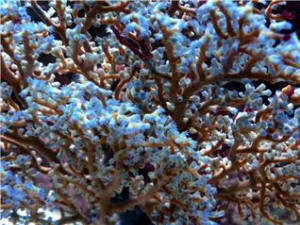
|
| ID help on a gorgonian please '¦Not
sure 11/11/07 Dear Experts <Mmm, don't think
I'd go quite that far, how about, learners, wanting to learn
more?> I have just obtained a sea fan from a well-known UK frag
outfit, and it was described as a 'purple sea fan'.
<WOW! Purple you say! This outfitter needs to get some women, or
men with out X's that are altered for colorblindness in their
packaging department! Good grief!> It's in my QT, and the
polyps are coming out nicely (been with me two days now). It's
near the surface, perhaps 6 inches from a single 36W PC with
reflector, so it doesn't seem to mind light. <Does not look
like a photosynthetic species to me.> There's a 60GPH
powerhead in about 3 gal of water, bouncing off a corner, so a fair
current flowing over the creature. I chose this variety as having
Zooxanthellae, and hence not too hard to keep... <Well it is
doubtful that is what you received here my friend.> It's
beautiful, but not really purple. <Heehee! Guess you're not
color blind either!> (Photo attached - from top to bottom is 3.5
inches). Stems are light orange, with deep red polyps. On searching
the web, I suspect it's Swiftia exserta. <Possibly, though
it does look a little different. These images seem closer but fail
to give the Latin name (Or accurate info for that matter... )
http://www.thatpetplace.com/pet/group/2773/product.web
http://www.aquacon.com/seafan.html > The picture in 'The
Reef Aquarium' (vol 2), however, shows each calyx are being
raised when the polyps are withdrawn, and my stems are quite smooth
- just a red spot remains. <Yes, I noticed that as well.>
Question one - have I got the ID right - I'm (clearly) no coral
expert <Mmm, I'm thinking no. But unfortunately I don't
have a better suggestion.> Question two - if I'm right, what
does it need to be fed? <I strongly suspect that this gorgonian
will need some sort of supplemental feeding to survive and highly
doubt that it is photosynthetic.> Given the polyps are between
2-3mm across, I guess something rather small. <Likely so.>
(We have brine shrimp and Nanochloropsis algae available - do I
need to wake up some Brachionus rotifer eggs that I've got?)
<Really not sure, may be a matter of trial and error.> I
didn't intend getting a sea fan that needs feeding, <You are
wise.> but it's lovely, <Yes, but that doesn't mean
it's appropriate for captive care.> and I don't want it
to die. <I wish it wasn't removed from the sea.> My main
tank has too much algae (50 US gal plus 10 sump), two clownfish, a
Royal Gramma, clove polyps, 4*36W PC in reflectors, and decent
water quality (no NH3, no NO2, <0.5ppm NO3, <5ppm PO4,pH
cycles 8.2-8.4, dKH 10, Ca 520ppm, Kalk pumped to hold pH). On the
good side, all sorts of 'stuff' from the live rock is
breeding (Stomatella snail, Collonista snails, Syconoid sponge,
Homotrema forams, Spirorbis worms, rotifers, ...) so I hope there
may be something that suits the sea fan. <I hope you are right,
but I am doubtful.> (I will feed it if needed, but it's much
safer if there are things growing that are suitable) <Perhaps
there are, I hope there are, but unfortunately I doubt there
are.> Thanks for a great site <On behalf of Bob and
--David |
|
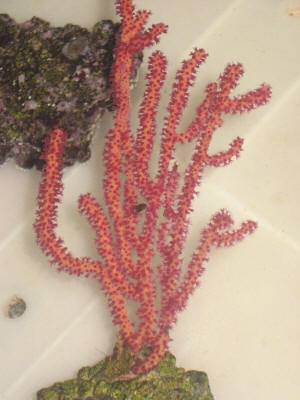
|
|
Gorgonian ID and Care Question 8/24/07 Hi
crew- <Hi Jim, Mich helping out tonight.> I have a lovely
gorgonian that I have been unable to positively identify. <Is
a beauty for sure! I have not been able to find anything that I
am convinced of as far as an ID goes. When I initially looked at
the pic I thought it was a Yellow gorgonian (Diodogorgia
nodulifera), but no. I don't think it is. Closest I've
seen and I don't really think that's it either is an
Acalycigorgia sp, but this is really a guess at best. You can
read a little more here: http://www.wetwebmedia.com/seafans.htm
> This makes it somewhat hard to know how to provide optimal
care. <I absolutely understand, but even with a positive ID it
is often difficult to provide appropriate care, as the natural
diets of many of these creatures are poorly understood. I'm
thinking your pretty one is non-photosynthetic and will require
supplemental feedings, unfortunately the nutritional requirements
vary and are again are not well understood. Because of this,
non-photosynthetic gorgonians seldom do well for long in
captivity. You may try supplementing with planktonic animals such
as Artemia nauplii, or other very fine particulate foods, but
this lovely creature may require something completely
different.> I have attached a pic - any idea what it is and
how to best care for it? <I'm sad to say, I'm not able
to give you much guidance here. Perhaps RMF will chime in.>
<<Mmm, where did you get this? Did your supplier state
which sea it hailed from? Might be of either stated genus... not
easily kept... RMF>> many thanks- <Sorry I'm not of
more help. Mich> Jim Gray
Re: gorgonian ID and care question 7/25/07
Hi Mich- <Hi Jim> Thanks for the response. <Welcome.>
If anyone else in your group can help with an ID and care
suggestions, that would be great. <Mmm, Bob commented on the
dailies page, I've copied his reply below. He has by far the
most experience of anyone here... <<Mmm, where did you get
this? Did your supplier state which sea it hailed from? Might be
of either stated genus... not easily kept... RMF>> I have
it in strong flow and light currently. Should I reduce the amount
of light it gets? <As long as you don't get algae growth
and have polyp expansion I think I would keep it where it's
at on the off chance it is photosynthetic, which I highly
doubt.> Might these prefer low light? <I suspect it came
from lower light conditions.> Any other suggestions on food?
<Try anything, finely, finely minced.> thanks...
<Welcome, sorry Jim
|
|
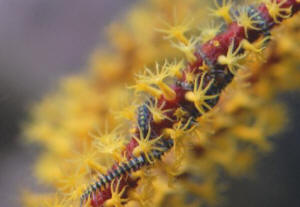
|
| Follow up on Sponge/Anemone ID 8/15/07 >
> Subject: Sponge/Anemone ID, and Mantis comp. > Hi guys,
just a quick thank you for the much appreciated information on your
site.> I was told at my LFS that this is a colonial anemone on a
sponge, an "orange spider sponge"; is this correct?>
<Mmm, maybe... are the grayish parts ever
"polyp-like"? This may be a sponge growing on another
> if so what is the taxonomy.> <Any idea where this/these
organism/s are from?>> Also, are mantis shrimp detrimental to
a reef setup?> <Can definitely be... are predaceous... some
can get quite large, consume shellfish, other crustaceans, even
fishes>> I have had no luck removing this specimen, I got a
snowflake eel, not solely for the purpose but thinking he might
dine on it, but alas he hasn't. I'm starting to admire his
resilience. Thank you for your assistance. Cameron Teague>
<See WWM re traps, baiting... strategies. Bob Fenner>> Hi,
I have been told that they have "flowers", I'm
guessing polyps, that emerge after time. I have only had it in my
system for about a week. I'm guessing it's just getting
used to my system. The supply from my LFS comes from Cairns, then
gets shipped over night to Hobart, Tasmania where I live.>
<Mmm, well... the polyps should have been in evidence by now...
I do suspect that this is a sponge on a sponge more and more.
BobF> Well it's been about two weeks and polyps are staring
to appear. What does this mean? Apart from it's alive. Does
that mean it's not a sponge? <You know... with this nice
close-up pic... I do think this is an encrusting Gorgonian (an
octocoral... Sea Fan), not an Anemone (Hexacorallian) at all. See
the Net re... Oh, is NOT a sponge. BobF> |
|
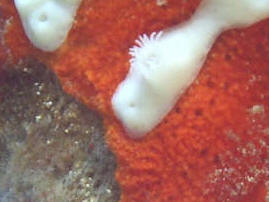 .JPG)
|
Is This a Briareum Species Of Gorgonian?
Yep -- 05/03/07 Hello! <<Hi>> Well I wrote
yesterday and asked about the lighting requirements for my newly
acquired gorgonian. <<Yes, I recall>> I learned that
photosynthetic gorgonians can be very toxic, so I wanted to try to
establish a positive ID on this one. <<Mmm, not just the
photosynthetic species...gorgonians as a whole are quite
noxious>> I suspected it to be of Briareum
species. Most importantly, whatever this may be, is this
particular species toxic? <<In the sense that it can exude
chemicals to limit growth/vitality of the corals/organisms around
it...yes...but so too can those Hairy Mushrooms and Protopalythoa
you said you have in this tank>> I hear that Briareum also
encompasses Star Polyps. <<Indeed...a few species about (e.g.
- Briareum violacea, Briareum stechei)>> It's been 5 days
now and all my other colonies are in perfect health, including my
Favites brain that is like 3-4 inches away from it. Am I
to assume this means that it's a non-toxic species?
<<Nope...the effects of allelopathy (the chemical warfare
waged by most all corals/sponges/etc.) are not always immediately
apparent. I suggest you do a keyword search of our site
re 'allelopathy' and read up>> Or just that toxins
haven't risen to a high enough level yet? <<There may or
may not be any problems that arise from the presence of the
gorgonian depending on your tank husbandry/maintenance
processes...but the effects of allelopathy can/will be mitigated
through the use of chemical filtration (carbon and/or
Poly-Filter)>> No carbon being run currently. <<Would
help/is of benefit to any system in my opinion>> The picture
I have attached is a close-up, it has a branching configuration but
another one at the store looked more like an encrusting pile.
<<The polyps do look 'Briareum like'...have a look
here about midway down the page and see what you think: http://www.wetwebmedia.com/seafans.htm >> Hope
it's good enough to establish an ID from. (forgive the polyps,
they are still adapting to the tank conditions). Best Regards,
Mark Forsling
<<Be chatting, EricR>> |
|
Re: Is This a Briareum Species Of Gorgonian? --
05/03/07 Thanks for your reply. <<Welcome>> I
checked out the page and it definitely seems to be a Briareum
species. <<Yes...Bob thinks so too>> I've been
really just relying on skimmer (Read Sea Prizm), water changes
and live rock for filtration in the past. <<Nothing
'wrong' with this>> There is however a lot of
differencing opinions among aquarist on how often and how long to
use carbon. <<Agreed>> What would be your
recommendation on for how long a duration and how frequently to
use carbon given the setup and coral population? <<I would
use a small amount of carbon (a cup or two) continuously
(24/7)...changed out once or twice a
month. EricR>> Regards, Mark
|
|

|
Sea fan approximation 02/12/06 WWM Crew,
<<Arnold>> I am requesting your assistance in identifying a
particular type of coral I have acquired. It is yellow in
color, resembles a dead tree in shape, and has white polyps protruding
out from the entirety of the structure. Any help you could
provide would be greatly appreciated. Thank you for your
time. Sincerely, Arnold <<No way to say without a sharp close-up
photo. But I'm going to venture a guess here and say you
have a non-photosynthetic gorgonian...will likely starve to death
within months. You really should research your livestock
BEFORE you acquire it my friend. Regards, EricR >>
|
|

